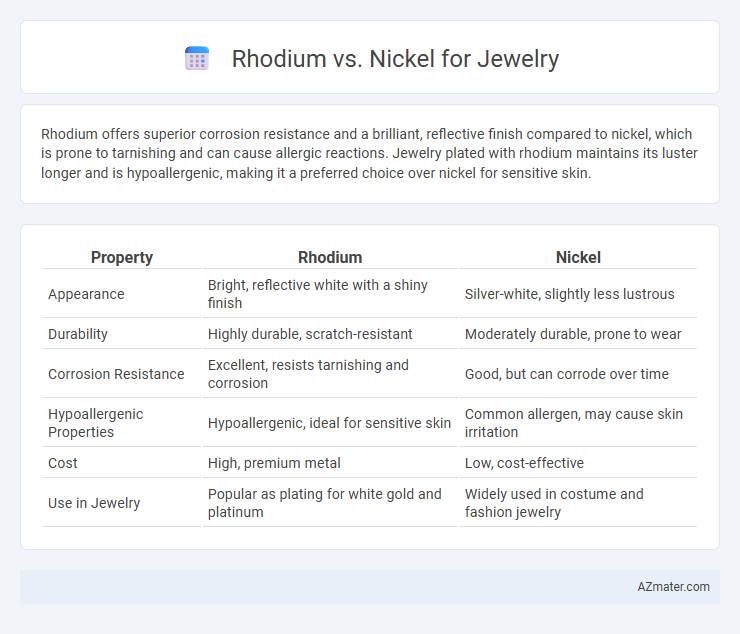Rhodium offers superior corrosion resistance and a brilliant, reflective finish compared to nickel, which is prone to tarnishing and can cause allergic reactions. Jewelry plated with rhodium maintains its luster longer and is hypoallergenic, making it a preferred choice over nickel for sensitive skin.
Table of Comparison
| Property | Rhodium | Nickel |
|---|---|---|
| Appearance | Bright, reflective white with a shiny finish | Silver-white, slightly less lustrous |
| Durability | Highly durable, scratch-resistant | Moderately durable, prone to wear |
| Corrosion Resistance | Excellent, resists tarnishing and corrosion | Good, but can corrode over time |
| Hypoallergenic Properties | Hypoallergenic, ideal for sensitive skin | Common allergen, may cause skin irritation |
| Cost | High, premium metal | Low, cost-effective |
| Use in Jewelry | Popular as plating for white gold and platinum | Widely used in costume and fashion jewelry |
Introduction to Rhodium and Nickel in Jewelry
Rhodium, a rare and lustrous platinum-group metal, is prized in jewelry for its reflective white finish and exceptional resistance to tarnish and corrosion. Nickel, a more abundant and affordable metal, is widely used in jewelry alloys to enhance strength and durability but can cause allergic reactions in sensitive individuals. The distinct properties of rhodium and nickel influence their applications, with rhodium commonly used as a plating material for white gold and silver, while nickel serves as a base metal in costume jewelry and mixed alloys.
Physical Properties: Rhodium vs Nickel
Rhodium exhibits superior hardness and corrosion resistance compared to nickel, making it ideal for durable and tarnish-resistant jewelry coatings. Nickel offers greater ductility and flexibility but is prone to oxidation, which can lead to discoloration over time. The higher melting point of rhodium (1,964degC) versus nickel (1,455degC) also contributes to its enhanced thermal stability in jewelry applications.
Appearance and Finish: Shine, Color, and Texture
Rhodium provides a brilliant, mirror-like shine with a cool, silvery-white color that enhances the brightness of white gold and platinum jewelry, offering a smooth and reflective finish. Nickel, while durable, has a duller silver-gray appearance that can develop a darker patina over time, leading to a less lustrous surface. The texture of rhodium plating is typically smoother and more scratch-resistant compared to nickel, making rhodium a preferred choice for high-end jewelry seeking a pristine and enduring finish.
Durability and Wear Resistance Comparison
Rhodium plating offers superior durability and exceptional wear resistance, making it ideal for protecting jewelry from scratches and tarnish over time. Nickel, while sturdy and commonly used in alloys, is more prone to oxidation and can cause skin irritation, reducing its practical wearability. Rhodium's hardness and corrosion resistance ensure longer-lasting shine and structural integrity compared to nickel-based jewelry components.
Hypoallergenic Qualities: Skin Sensitivity Issues
Rhodium is highly valued in jewelry for its hypoallergenic properties, making it an excellent choice for individuals with sensitive skin or allergies to metals. Nickel, commonly used as an alloy in jewelry, often causes allergic reactions such as itching, redness, and rashes due to its widespread sensitizing effects. Choosing rhodium-plated jewelry significantly reduces the risk of skin irritation and is preferred by those with nickel sensitivity or other metal allergies.
Tarnish and Corrosion Resistance
Rhodium offers superior tarnish and corrosion resistance compared to nickel, making it a preferred choice for high-quality jewelry finishes. Nickel tends to oxidize and darken over time, especially when exposed to moisture and skin oils, leading to visible tarnish. Rhodium's robust resistance to these effects ensures longer-lasting shine and durability in jewelry pieces.
Cost and Investment Value
Rhodium plating is significantly more expensive than nickel due to its rarity and reflective properties, commanding higher prices per gram in the precious metals market. Nickel, while affordable and commonly used as a base metal in jewelry, lacks intrinsic investment value and can cause allergic reactions, limiting its desirability. Rhodium's high market demand and resistance to tarnish make it a better long-term investment choice for durable, valuable jewelry finishes.
Maintenance and Care Requirements
Rhodium-plated jewelry requires periodic re-plating to maintain its reflective, tarnish-resistant surface, as the thin rhodium layer can wear off over time. Nickel jewelry demands regular cleaning and polishing to prevent oxidation and skin irritation, especially for those with metal sensitivities. Choosing rhodium plating offers lower long-term maintenance but may involve higher initial costs, whereas nickel requires consistent upkeep to preserve appearance and durability.
Common Uses in Jewelry Design
Rhodium is primarily used as a plating material in jewelry to enhance the shine and durability of white gold and silver pieces, creating a bright, reflective finish that resists tarnishing. Nickel, valued for its strength and malleability, is frequently alloyed with other metals to produce durable and cost-effective jewelry, but it can cause allergic reactions in sensitive skin. The choice between rhodium and nickel depends on the design requirements; rhodium plating is favored for its hypoallergenic properties and aesthetic appeal, while nickel alloys offer affordability and structural integrity in everyday jewelry.
Choosing Between Rhodium and Nickel for Jewelry
Choosing between rhodium and nickel for jewelry depends on factors such as durability, hypoallergenic properties, and appearance. Rhodium is a precious metal commonly used as a plating for white gold or silver to enhance shine and resist tarnishing, making it ideal for sensitive skin due to its hypoallergenic nature. Nickel, while affordable and durable, often triggers allergic reactions, which has led to strict regulations in many countries limiting its use in jewelry.

Infographic: Rhodium vs Nickel for Jewelry
 azmater.com
azmater.com